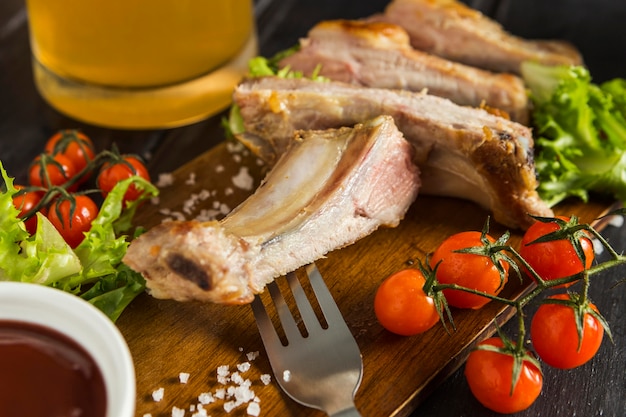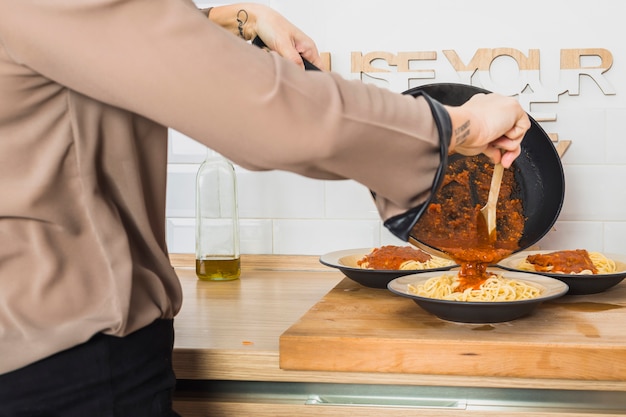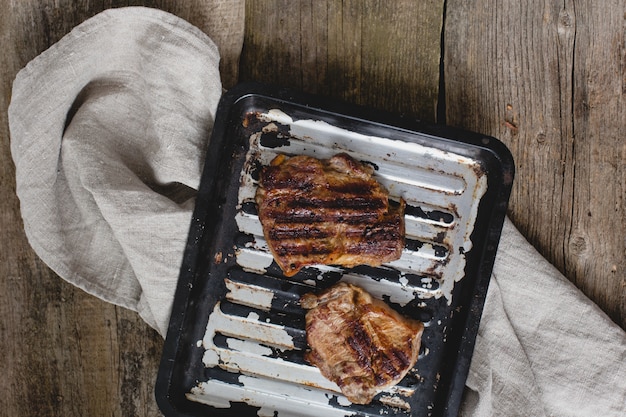The rump roast! A cut of beef that's often overlooked, but when cooked right, it can be a truly satisfying meal. I've spent years experimenting with different techniques, and I'm finally ready to share my secrets for achieving juicy, tender, bursting-with-flavor rump roast perfection.
Remember that time I tried to roast it at a scorching 200 degrees Celsius? It ended up with a charred outside and a raw inside. Talk about a disaster! And then there was the time I completely forgot about it in the oven, leaving it for what felt like an eternity. That resulted in something more akin to leather than food!
But those mishaps taught me valuable lessons. Through trial and error, I've developed a foolproof method that consistently delivers a delicious rump roast every time. So grab your apron, gather your ingredients, and let's embark on a culinary journey together!
(Part 1) Choosing the Right Rump Roast

The first step is picking the perfect rump roast. Just like choosing a good bottle of wine, it all starts with the ingredients. A good rump roast is a foundation for a fantastic meal, and there are a few things to look for when selecting your cut.
Look for Marbling
Marbling, those little streaks of fat throughout the meat, is your best friend when it comes to rump roast. The more marbling, the more flavor and tenderness you'll get. Think of it like the difference between a dry, dusty piece of bread and a rich, buttery brioche. The marbling adds that extra layer of richness and juiciness that makes the difference between an okay roast and a truly memorable one.
Don't Be Afraid of a Little Fat
The fat on the rump roast is key! It renders down during cooking, basting the meat and keeping it moist. It's like a natural self-basting system, ensuring that your roast stays juicy and flavorful. You can always trim off any excess fat after cooking, but don't be afraid to leave a little bit on there.
Check for Colour
A good rump roast will have a deep red color, with a slight marbling of white fat. Avoid any roasts that have a pale color or a greenish hue. These can be signs that the meat has been stored improperly or is not fresh.
(Part 2) Preparing the Rump Roast

Now that you've got your perfect rump roast, it's time to prepare it for cooking. This is where you start to transform that raw cut into something truly delicious.
Seasoning the Roast
Seasoning is a crucial step that brings out the flavor of the beef and makes a world of difference. I keep my seasoning simple: salt, pepper, and a touch of garlic powder.
- Salt: This is essential for drawing out moisture and adding flavor. Season generously, especially if you're using kosher salt.
- Pepper: Freshly ground black pepper adds a wonderful aroma and depth of flavor. Don't be shy with the pepper mill!
- Garlic Powder: A little bit of garlic powder goes a long way. It adds a subtle, savory note that complements the beef beautifully.
Of course, you can get creative and add other herbs and spices to suit your taste. You can experiment with rosemary, thyme, oregano, paprika, or even a blend of your favorite spices. There are endless possibilities!
Sear the Roast (Optional)
Searing the roast before roasting is optional, but it can really amp up the flavor and texture. It gives the roast a nice crispy crust and locks in those delicious juices.
- How to Sear: Heat a heavy-bottomed skillet or cast iron pan over high heat. Add a drizzle of oil and sear the roast on all sides for about 2-3 minutes per side, or until nicely browned.
- When to Skip Searing: You can skip searing if you're short on time, or if you're concerned about the fat rendering too much during cooking.
(Part 3) The Secret to Juicy, Tender Perfection

Here comes the crucial part – the cooking. This is where you'll really need to pay attention to ensure your rump roast comes out juicy and tender.
Low and Slow
The secret to a juicy, tender rump roast is to cook it low and slow. This allows the meat to cook evenly and the fat to render down, creating a rich, flavorful sauce. It's a bit like slow-cooking a delicious stew – it takes time, but the results are worth it.
Oven Temperature
I find that 150 degrees Celsius (300 degrees Fahrenheit) is the perfect temperature for roasting a rump roast. It's low enough to prevent the meat from drying out, but high enough to ensure a nice, even cook.
cooking time
The cooking time will vary depending on the size of your roast. A good rule of thumb is to cook for 15-20 minutes per pound. However, the best way to determine if your roast is cooked through is to use a meat thermometer.
Insert the thermometer into the thickest part of the roast, making sure it doesn't touch any bone. The roast is done when the internal temperature reaches 145 degrees Fahrenheit for medium-rare.
(Part 4) Resting the Roast
After the roast is cooked, don't rush to slice it up right away! It needs to rest for at least 15 minutes to allow the juices to redistribute throughout the meat. This will ensure that you have a juicy, tender roast, and not a dry, disappointing one.
Resting Time
I usually let my rump roast rest for 30 minutes. This gives the juices ample time to settle back into the meat. It's like a little spa treatment for your roast, allowing it to relax and regain its moisture.
Cover the Roast
While the roast is resting, cover it loosely with foil. This will help to trap in the heat and moisture. It's like wrapping your roast in a warm, cozy blanket.
(Part 5) Serving the Roast
Once the roast has rested, it's time to slice it up and serve it with your favorite sides. I like to serve my rump roast with roasted vegetables, mashed potatoes, and a hearty gravy.
Slicing the Roast
Use a sharp knife to slice the roast against the grain. This will help to make the meat tender and easy to chew. If you're slicing it for sandwiches, you can cut it into thinner slices.
Serving Suggestions
There are endless ways to serve a rump roast. Here are a few of my favorites:
- Classic roast beef Dinner: Served with mashed potatoes, roasted vegetables, Yorkshire pudding, and gravy.
- Beef Sandwiches: Thinly sliced roast beef on crusty bread with your favorite toppings.
- Beef and Caramelized onion salad: Thinly sliced roast beef on a bed of greens with caramelized onions, crumbled blue cheese, and a balsamic vinaigrette.
(Part 6) Variations on the Rump Roast
The beauty of a rump roast is its versatility. You can cook it in so many different ways, and it always tastes delicious. Here are a few variations to try:
Rump Roast with Herbs and Garlic
This is a simple and classic recipe that's sure to please. Season the roast with fresh rosemary, thyme, and garlic. Roast it in the oven until tender, and serve with roasted vegetables.
Rump Roast with Red Wine Sauce
This is a more sophisticated version of the rump roast. After searing the roast, add a cup of red wine to the pan and simmer until it reduces by half. Pour the sauce over the roast and continue cooking in the oven until tender.
Rump Roast with Dijon Mustard Glaze
This is a flavorful and tangy variation on the rump roast. Mix together Dijon mustard, honey, and a little bit of garlic powder. Spread the glaze over the roast and roast in the oven until tender.
(Part 7) Tips and Tricks
Here are a few tips and tricks to help you achieve rump roast perfection:
- Don’t Overcrowd the Pan: Make sure your roast has enough space to cook evenly. If you’re cooking a large roast, you may need to use a larger roasting pan.
- Use a Meat Thermometer: This is the best way to ensure that your roast is cooked to the desired doneness.
- Don’t Overcook It: Overcooked roast beef can be dry and tough. Use a meat thermometer to ensure that it’s cooked to the desired doneness.
- Make a Gravy: Use the pan juices to make a delicious gravy. Simply deglaze the pan with a little bit of wine or broth, and simmer until the sauce thickens.
- Try a Dry Brine: This is a great way to enhance flavor and tenderness. Simply rub the roast with salt and let it sit in the refrigerator for 12-24 hours before cooking. The salt will draw out moisture and then reabsorb it, resulting in a more flavorful and juicy roast.
- Consider a reverse sear: This technique involves cooking the roast at a low temperature for an extended period of time, and then searing it at high heat to create a crispy crust. It's a great way to ensure a perfectly cooked roast that's both tender and flavorful.
(Part 8) Storing and Reheating Leftovers
Rump roast leftovers are just as delicious as the original! Here’s how to store and reheat them.
Storing Leftovers
Let the roast cool completely before storing it in the refrigerator. Store it in an airtight container for up to 4 days.
Reheating Leftovers
You can reheat the roast in the oven, microwave, or on the stovetop.
- Oven: Preheat the oven to 150 degrees Celsius (300 degrees Fahrenheit). Place the roast in a baking dish and heat until warmed through.
- Microwave: Place the roast in a microwave-safe dish and heat on high for 1-2 minutes per serving.
- Stovetop: Place the roast in a skillet over medium heat. Heat until warmed through, stirring occasionally.
(Part 9) FAQs
What is a Rump Roast?
A rump roast is a cut of beef that comes from the rear end of the animal. It’s a very flavorful and versatile cut, perfect for roasting, grilling, or braising. It’s also relatively inexpensive, making it a great value for your money.
How Long Does It Take to Cook a Rump Roast?
The cooking time for a rump roast will vary depending on the size and thickness of the roast. As a general rule, you can expect to cook it for 15-20 minutes per pound at 150 degrees Celsius (300 degrees Fahrenheit).
What is the Best Way to Cook a Rump Roast?
The best way to cook a rump roast is to roast it in the oven at a low temperature, around 150 degrees Celsius (300 degrees Fahrenheit). This will allow the meat to cook evenly and the fat to render down, resulting in a juicy and tender roast.
What Goes Well with Rump Roast?
Rump roast pairs well with a variety of sides, such as roasted vegetables, mashed potatoes, Yorkshire pudding, and gravy. It also works well in sandwiches and salads.
What is the Best Way to Reheat Rump Roast Leftovers?
The best way to reheat rump roast leftovers is to bake them in the oven at a low temperature, around 150 degrees Celsius (300 degrees Fahrenheit). This will help to keep the meat moist and tender. You can also reheat it in the microwave, but it’s important to heat it slowly to prevent it from drying out.
(Part 10) My Final Thoughts
I've come a long way since those early culinary blunders with the rump roast. Now, I feel like I can confidently say I've mastered the art of roasting this versatile cut of beef.
I've learned that cooking the rump roast is all about patience and attention to detail. It's not about rushing the process, but about taking the time to let the meat cook slowly and evenly. It's about understanding how to season it properly, how to sear it for a delicious crust, and how to cook it at the perfect temperature.
And most importantly, it's about enjoying the process. From choosing the right roast to slicing it up and serving it with all your favorite sides, cooking a rump roast is an experience that brings joy to both the cook and the guests.
So the next time you're looking for a delicious and affordable meal, give the rump roast a try. You won't be disappointed!
(Part 11) A Visual Guide to a Perfect Rump Roast
To make things even clearer, here's a visual guide to help you understand the process of cooking a perfect rump roast:
| Step | Description | Image |
|---|---|---|
| 1 | Choose a rump roast with good marbling. | [Image of a rump roast with good marbling] |
| 2 | Season the roast with salt, pepper, and garlic powder (or your favorite spices). | [Image of the rump roast being seasoned] |
| 3 | Sear the roast on all sides for a crispy crust (optional). | [Image of the rump roast being seared in a pan] |
| 4 | Place the roast in a roasting pan and cook in a preheated oven at 150 degrees Celsius (300 degrees Fahrenheit) for 15-20 minutes per pound. | [Image of the rump roast in the oven] |
| 5 | Use a meat thermometer to check the internal temperature. The roast is done when it reaches 145 degrees Fahrenheit for medium-rare. | [Image of a meat thermometer inserted into the rump roast] |
| 6 | Remove the roast from the oven and let it rest for 15-30 minutes before slicing. | [Image of the rump roast resting on a cutting board] |
| 7 | Slice the roast against the grain and serve with your favorite sides. | [Image of the sliced rump roast being served with sides] |
With this comprehensive guide and the visual aid, you'll be well on your way to mastering the art of cooking a delicious and impressive rump roast. Happy cooking!
Everyone is watching

How to Cook Frozen Lobster Tails Perfectly: A Step-by-Step Guide
RecipesLobster. Just the word conjures up images of lavish meals, special occasions, and a taste of luxury. But let's...

Pigs in a Blanket Cooking Time: How Long to Bake for Perfect Results
RecipesAh, pigs in a blanket. Just the name conjures up images of those delightful little parcels of crispy pastry en...

Pork Fillet Cooking Time: How Long to Cook It Perfectly
RecipesPork fillet, or tenderloin as it's sometimes called, is a real favourite in our house. It's so versatile, and...

The Ultimate Guide to Tender, Juicy Pulled Pork
RecipesRight, let's talk pulled pork. It's one of those dishes that just screams "comfort food," doesn't it? I mean...

The Ultimate Guide to Cooking Delicious Frankfurters
RecipesLet's face it, we all love a good frankfurter. It's a classic, simple, and always satisfying. But let's be rea...
